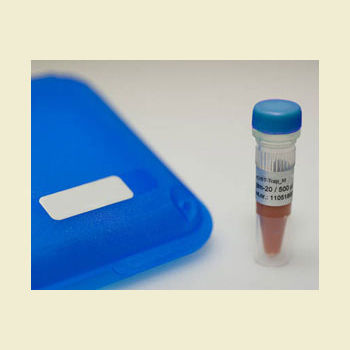
- Laboratory
- Laboratory medicine
- Monoclonal antibody
- Bulldog Bio, Inc.
Monoclonal antibody mNeonGreen-Trapenzymefor Western blotprotein
Add to favorites
Compare this product
Characteristics
- Type
- monoclonal antibody, enzyme
- Applications
- for Western blot
- Tested parameter
- protein
- Micro-organism
- bacteria
Description
Novel Binding Protein for mNeonGreen Studies
Analyze mNeonGreen fusion proteins in a tube
As imaging technology advances, many researchers have turned toward super resolution imaging platforms. Common fluorophores, such as GFP, may not always be the best fit for this application. mNeonGreen is an ultra-bright monomeric yellow-green fluorescent proteins derived from the lancelet, Branchiostoma lanceolatum. mNeonGreen fusions are a great choice for use in fluorescence, confocal & super resolution microscopy. With the mNeonGreen-Trap, specific for this non-GFP variant, yields of fusion proteins purification are high and free from heavy and light-chain contaminants, all in under 30 minutes. Save time, save effort and get cleaner results.
The secret to mNeonGreen-Traps success are the use of super-high affinity Camelidae antibody fragments called Nanobodies. mNeonGreen-Traps may be used for immuno-precipitation, immuno-purification and immuno-pull down experiments with up to 10-fold better purity and yield than that of classic mouse monoclonal antibodies. Compatible with a variety of source materials, Nanobody-Traps may be used with mammalian cells, tissues & organs, bacteria, yeast and even plants. These reagents allow your mNeonGreen-fusions to be perfect candidates for immunoprecipitations, Co-IP, mass spectroscopy, and enzyme activity measurements.
mNeonGreen-Trap for immunoprecipitations
Immunoprecipitations (IP) of mNeonGreen from protein extracts of mNeonGreen-expressing E.coli cells.
Catalogs
No catalogs are available for this product.
See all of Bulldog Bio, Inc.‘s catalogsRelated Searches
- Solution reagent kit
- Molecular biology reagent kit
- Research reagent kit
- Protein reagent kit
- Laboratory reagent kit
- Enzyme reagent kit
- Histology reagent kit
- Reagent medium reagent kit
- Cytology reagent kit
- Dye reagent
- Antibody
- Buffer solution reagent kit
- Clinical chemistry reagent
- PCR reagent kit
- Bacteria reagent kit
- Blood sample reagent kit
- Tissue reagent kit
- DNA extraction reagent kit
- Electrolyte reagent kit
- Enzymatic reagent kit
*Prices are pre-tax. They exclude delivery charges and customs duties and do not include additional charges for installation or activation options. Prices are indicative only and may vary by country, with changes to the cost of raw materials and exchange rates.




